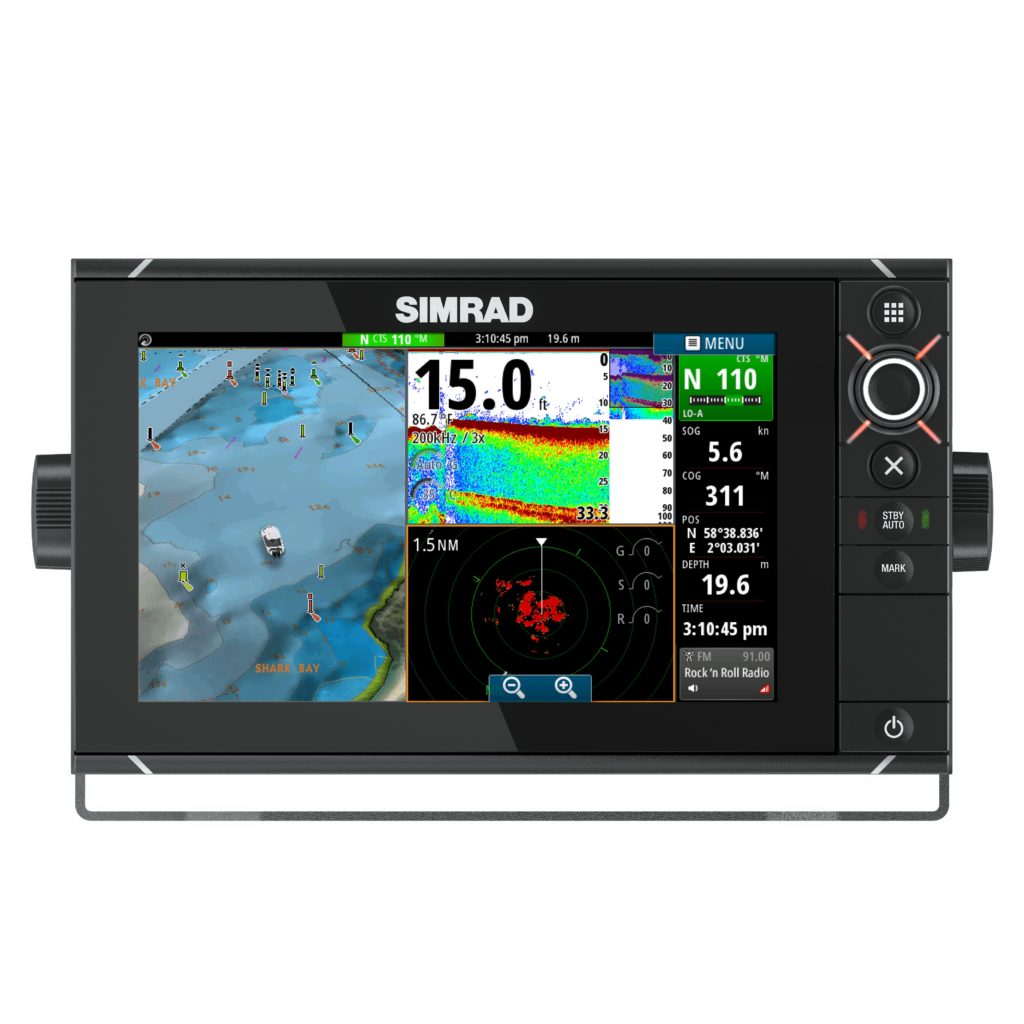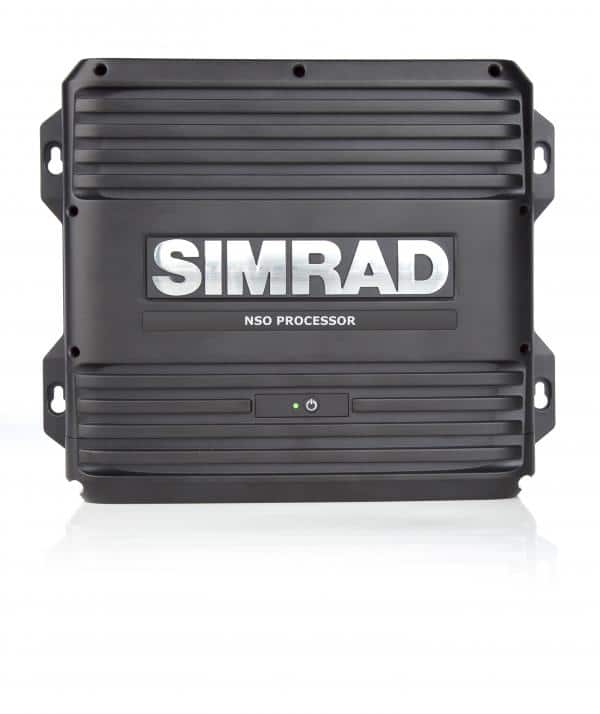
NSS
Designing a cutting-edge multifunction display (MFD) or dedicated black-box computer isn’t easy. Modern standards dictate that the device possess PC-like processing power, an intuitive and easy-to-use user interface (UI) and a touch-screen interface that favors spacious sweeps of glass rather than banks of hard keys. Today’s state-of-the-art MFDs and dedicated processors must also feature bright, beautiful graphics on sunlight-viewable screens, Wi-Fi compatibility and the ability to network with all onboard instrumentation including radar, engine and vessel data, and autopilot. Finally, international standards also demand that new MFDs/black boxes come bundled in a low-profile, weather-resistant housing. All this, and a price tag that doesn’t consume your season’s cruising kitty.
Simrad‘s two newest MFD and black-box solutions were designed to exceed these criteria while giving users maximum screen space. The NSS evo2 ($1,529 to $5,699, model depending) is a standalone MFD, while the NSO evo2 Marine Processor ($5,695) is a black-box computer designed to pair with one or two of Simrad’s new wide-screen, touch-screen and non-touch-screen MO-series monitors ($2,999 to $8,995, model depending) to create an all-glass bridge. Both systems use tablet-style processor chips (read: low power draw and low heat emissions), and both use identical operating systems (OS) and UIs.
“We challenge our UI guys to create what we call walk-up usability,” says Dennis Hogan, Simrad’s global brand director. Start playing with the NSS evo2 or the NSO evo2 and this walk-up usability quickly obviates the need for an instruction manual for all but the most technical tasks. Once properly installed and networked, both the NSS evo2 and NSO evo2 feature a home page with customizable wallpaper and an easy-to-navigate, tablet-style icon matrix that gives a user one-tap access to all instrumentation, ranging from the chart plotter and broadband radar to night-vision camera controls. Both units feature a fully customizable data bar (which can be populated with any user-selected data sources) that includes widgets for the autopilot and a Simrad SonicHub ($599), as well as a dedicated MOB button.
Additionally, both systems come loaded with proprietary Simrad technologies including user-created Insight Genesis cartography, cutting-edge chart-plotting features such as “Look Ahead,” “Cursor Mode” and “Cursor Assist” and seamless autopilot integration (including features such as “No Drift Mode” and “Power Steer”) that eliminate the need for a dedicated autopilot-control head.
To accommodate vessels ranging from tenders to sophisticated sport-fishing rigs, the smallest NSS evo2 is available with a 7-inch screen, followed by 9-inch and 12-inch models, while the biggest NSS evo2 comes with a 16-inch display designed to be flush-mounted onto a helm (the smaller units can be flush-mounted or can use a vertical mounting bracket). All four NSS models feature a TouchSensible interface that includes a pinch-to-zoom touchscreen, as well as a narrow-beam vertical strip of real estate — located on the screen’s right-hand side — that houses a rotary, push-to-enter knob, a dedicated home-screen button, a minimalist keypad and two Secure Digital (SD) cartography slots. All NSS evo2 units play nicely with Insight, C-Map MAX-N and Navionics Gold and Platinum, and the last allows a user to view two types of cartography simultaneously via the unit’s optional split-screen view. Each NSS evo2 MFD features a built-in 10 Hz high-gain GPS/GLONASS antenna, embedded sonar capabilities (CHIRP-enabled broadband sounder and StructureScan sounder) and LED backlit screens (resolution varies by screen size), and the unit can store up to 10,000 waypoints. Additionally, the 7- and 9-inch models each have one Ethernet port, while the 12- and 16-inch units have two Ethernet ports, allowing users to network as many as six NSS evo2 MFDs. All NSS evo2 units have an operating voltage range of 9 to 32 volts DC, are built to IPX-7 standards and are compatible with Simrad’s GoFree WiFi-1 module ($229), giving you the ability to monitor all networked instrumentation and vessel data wirelessly via your smartphone or tablet.
Given the impressive processing, graphics and connectivity power that come bundled into each NSS evo2, knowing when to upgrade to the NSO evo2 black-box system isn’t as straightforward as it was with previous generations of marine electronics. While the NSS evo2 is available in a spacious 16-inch screen size — offering customers more screen acreage than most other MFDs — there’s no question that even bigger glass offers a better on-the-water experience, provided you have enough helm space. Simrad’s NSO evo2 is offered with 16-, 19- and 24-inch wide-screen monitors. “The biggest difference between the NSS evo2 and the NSO evo2 is screen size, and the NSO also has a more powerful processor to drive bigger graphics,” says Mike Fargo, Simrad’s product line director. “We think that we can convert people to bigger screens.”
The NSO evo2 Marine Processor is weatherproof to IPX-2 standards and is bundled in a tidy case that weighs just 2.2 pounds. The black box comes fitted with molded-in mounts, allowing the device to be installed almost anywhere. Crucially, the NSO evo2 has two independent quad-core processors that run their own copy of Simrad’s OS. Fargo says the NSO evo2 is the world’s first black-box MFD to offer dual-discrete HD video output, which gives users the processing and video output power of two separate black-box units that share a single power source. This means the NSO evo2 can drive two different wide-screen MO-series monitors (either side by side on a glass-bridge installation or perhaps one at the main helm and the other on the flybridge), or a user could connect a single monitor and a GoFree WiFi-1 module to his NSO evo2, giving him a dedicated monitor and wireless access to all networked vessel data (NMEA 0183 and 2000) via wireless devices. Additionally, the NSO evo2 is equipped with a single SD socket for cartography (including C-MAP, Navionics’ Gold and Platinum, Insight Genesis and NV Digital Charts) and three Ethernet ports, and it has an operating voltage range of 9 to 31.2 volts DC. “The NSO really shines when you want to have multiple monitors around the boat,” Hogan says. “Larger yachts might have up to six [networked NSO] black boxes aboard, running multiple monitors.”
Also, like the NSS evo2, the NSO evo2 features a TouchSensible interface, meaning users can enjoy the MO-series pinch-to-zoom interface, or — when the seaway is too lumpy for touch-screen navigation or if owners have spec’d non-touch-sensitive MO-series monitors — the NSO evo2 can be controlled by a Simrad NSO OP40 wired controller ($399).
Simrad’s NSS and NSO evo2 systems are strong contenders, should you be looking for new MFDs or an all-glass bridge. Also, given that they share the same OS — making it easy to jump from the MFD to the black-box unit and vice versa — the NSO evo2 could be a great match for your yacht’s helm stations, while the NSS evo2 could help transform your tender into the most sophisticated dinghy on the dock.
The evo2 black box (below) can drive two different wide-screen monitors or a single wide-screen display and Go-Free WiFi-1 module.

More Options
While the Simrad NSO and NSS evo2 are innovative chart-plotting technologies, competition always makes the marketplace better for consumers. In the case of the NSS evo2, the full-function MFD finds itself competing directly with Furuno’s line of TZtouch MFDs, as well as Raymarine’s e-series plotters, while the NSO evo2 black-box processor draws its closest market competition from Furuno’s TZT Black Box system.









